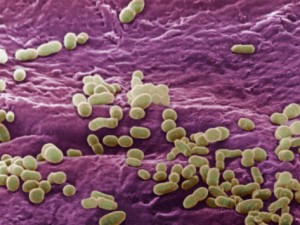 The body’s first lines of defense against illness is a delicate balance between cells and the millions of bacteria and other one-celled microbes that live on our skin. The National Institutes of Health researchers have set out to explore the skin’s DNA, and of all of the microbes that inhabit human skin. Their initial analysis, published today in the journal Science, reveals that our skin is home to much more bacteria than previously thought.
The body’s first lines of defense against illness is a delicate balance between cells and the millions of bacteria and other one-celled microbes that live on our skin. The National Institutes of Health researchers have set out to explore the skin’s DNA, and of all of the microbes that inhabit human skin. Their initial analysis, published today in the journal Science, reveals that our skin is home to much more bacteria than previously thought.
The study also shows that among healthy people, the greatest bacteria appear to be body location. The bacteria growing under a person’s arms likely are more similar to those under another person’s arm than they are to the bacteria that live on a person’s forearm.
“Our work has laid an essential foundation for researchers who are working to develop new and better strategies for treating and preventing skin diseases,” said Julia Segre, Ph.D., of the National Human Genome Research Institute (NHGRI), who was the study’s senior author. “The data generated by our study are freely available to scientists around the world. We hope this will speed efforts to understand the complex genetic and environmental factors involved in eczema, psoriasis, acne, antibiotic-resistant infections and many other disorders affecting the skin.”
DNA technology and computational analysis, the research team from NHGRI, the National Cancer Institute (NCI) and the NIH Clinical Center uncovered a far more diverse collection of microbes on human skin than had been detected by traditional methods that involved growing microbial samples in the laboratory.
The NIH study involved taking skin samples from 20 sites on the bodies of 10 healthy volunteers. “We selected skin sites predisposed to certain dermatological disorders in which microbes have long been thought to play a role in disease activity,” said study coauthor Maria Turner, M.D., senior clinician in NCI’s Dermatology Branch.
The researchers extracted DNA from each sample and sequenced the 16S ribosomal RNA genes, which are a type of gene that is specific to bacteria. The researchers identified more than 112,000 bacterial gene sequences, which they then classified and compared. The analysis detected bacteria belonging to 19 different phyla and 205 different genera, with diversity at the species level being much greater than expected.
To find out how much the skin DNA differs among healthy people, the researchers studied many different scenarios. They found a huge amount of variation in the number of bacteria species at different places on the skin, with the most difference being seen on the forearm (44 species on average) and the most similarity behind the ear (19 species on average).
“Not only does our work shed new light on understanding an important aspect of skin biology, it provides yet another example of how genomic approaches can be applied to study important problems in biomedical research,” said NHGRI’s Scientific Director Eric D. Green, M.D., Ph.D., who is a co-author of the study. “This also demonstrates what can be achieved through efforts that pull together researchers from across NIH.”
The skin sites selected for the Science study examine: oily, moist and dry skin. The oily sites included between the eyebrows, beside the nose, inside the ear, back of the scalp, and upper chest and back. Moist areas were inside the nose, armpit, inner elbow, webbed area between the middle and ring fingers, side of the groin, top fold of the buttocks, behind the knee, bottom of the foot and the navel. Dry areas included the inside surface of the mid-forearm, the palm of the hand and the buttock. Researchers found that dry and moist skin had a broader variety of microbes than did oily skin. Oily skin contained the most uniform mix of microbes.
“Our results underscore that skin is home to vibrant communities of microbial life, which may significantly influence our health,” said the study’s first author, Elizabeth Grice, Ph.D., who is a postdoctoral fellow at NHGRI.
New Study Explores what Lives on Human Skin
You are here:
- Home
- Fenvir in the News
- New Study Explores what Lives…

